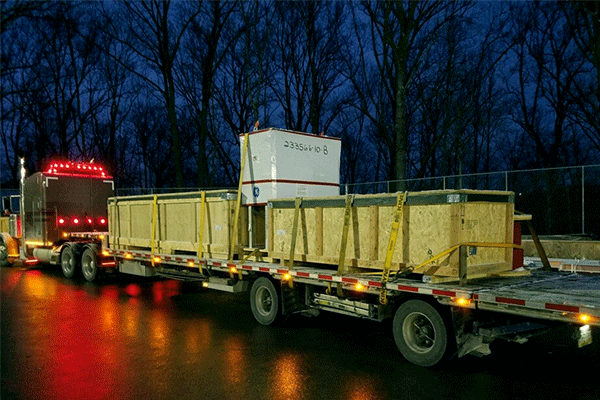- What first come, first served (FCFS) is
- What makes FCFS possible
- What FCFS means for truck drivers
- How FCFS impacts shipping price
The pricing structure in the freight shipping industry is complex. The price you pay to move your freight is subject to many variables and — in some cases — a first come, first served scheduling model is one such factor.
This article will round out your knowledge of what first come, first served truly means in freight shipping and how it impacts your shipments.
Here at Anderson Trucking Service (ATS), we’ve been working with shippers and receivers for more than 65 years during which time we’ve worked with first come, first served facilities around the nation.
As such, we understand FCFS and how important this warehouse/facility operations process is to the overall trucking industry.
Let's break down what FCFS is, the factors that allow providers to offer it, and how it affects truck drivers — and in turn, your rates.
What Does First Come, First Served Mean?
In the trucking industry, first come, first served (FCFS) refers to a scheduling model that prioritizes loading/offloading freight in the order the truck was received at the facility in question.
In most instances, carriers are presented a shipment with the recognition that they will either have an exact appointment time at which their driver must arrive or expect to be loaded/offloaded based on their order of arrival.
Typically, facilities that offer first come, first served capabilities do so within scheduled time-frames, which vary from company to company. This helps the shipper/receiver facility anticipate a greater volume of trucks at the load dock during a specific time and staff accordingly.
When executed skillfully, a FCFS model of open pickup/delivery scheduling can be a win-win situation for carriers, shippers, and drivers:
- Carriers enjoy greater flexibility control over their truck allocation and scheduling.
- Shippers/receivers no longer need to schedule and manage loading dock appointments on top of their regular duties.
- Drivers get the freedom to arrive at shipper/receiver facilities at any time that both fits their schedule and falls within the facilities' pre-set windows.
In theory, these are some compelling advantages to the FCFS model. But in reality, things aren't always so clear-cut.
FCFS Disadvantages
While a FCFS model is can be a boon in some scenarios, it's not without its downsides. The first is right there in the name: The first truck to come to the facility is the first to get served, i.e. loaded.
That means any trucks arriving later must wait their turn — no matter how urgent or critical their loads may be.
If the shipper/receiver can always efficiently load/offload trucks in the order they're received, this model works out beautifully. Unfortunately, that isn't always the case.
Drivers are often forced to wait for extended periods at FCFS facilities due to congestion at the loading dock. When facilities aren't operating at peak efficiency, that enviable flexibility can quickly turn into a golden cage that traps drivers in line for hours, potentially causing costly delays.
What Makes FCFS Possible for Shippers?
When FCFS is offered, it is typically by companies that have skilled, experienced FCFS workers to handle freight, plenty of yard/dock space, or both.
Some companies that deal with a high volume of freight in and out of their facilities invest the resources to employ highly-skilled full-time workers like crane operators, forklift drivers, and yard jockeys.
These employees typically have ample experience in FCFS freight and know how to efficiently handle, organize, and load/offload freight as it comes. Their expertise speeds up these vital shipping processes for both the shipper/receiver and the driver, making it a valuable investment for companies with the capital to swing it.
Aside from sheer manpower, space is the other crucial characteristic that helps make FCFS feasible for shippers and receivers.
Having a large amount of loading yard/dock space is key to this scheduling model, as multiple trucks will be arriving at any time and will need room to maneuver amongst each other.
If the company in question has enough space, they're more likely to be able to support an efficient loading/unloading process. Drivers are therefore less likely to be stuck in congestion at their dock, which keeps freight on-time and fee-free.
For shippers/receivers that possess the necessary “elbow room,” FCFS is a system that can save them time and money. For those that have both a deep bench of experienced FCFS dock workers and a large facility? FCFS is a no-brainer.
Truck Drivers and the First Come, First Served Model
First come, first served might make a lot of sense for freight shippers and receivers, but what about truck drivers? How does their job change when there's no specific appointment time that must be adhered to?
Well, it depends — but it can be a good thing.
Truck drivers have specific hours of service (HOS) regulations they must follow that are set by the Federal Motor Carrier Safety Administration to ensure road safety. Under these rules, drivers are not allowed to be actively “on duty” for more than 14 hours in a day.
That means drivers prioritize efficiency to help them optimize their HOS clock. When operating smoothly, FCFS facilities can aid drivers in this effort by allowing them to take greater control of their scheduling.
Of course, being the first in line to load/unload is the best-case scenario for a driver at a FCFS facility, but it would take an early bird with some serious dedication to nab that position every single time.
scheduling can quickly get out of hand as they wait for the countless trucks ahead of them.
As such, first-come-first-serve, although good for drivers in the sense that they can schedule deliveries outside of a set time slot, can also be damaging when FCFS facilities become over-congested.
 How a First Come, First Served Model Impacts Your Rate
How a First Come, First Served Model Impacts Your Rate
Freight rates are a complex beast to wrangle. They're difficult to generalize about and easy to misunderstand thanks to many factors that contribute to their calculation: Locations, urgency, commodity type, route, modes, market . . . the list could go on and on.
As you can imagine, throwing an FCFS model into the mix can have a ripple effect on rates. The intensity of those ripples —frog fart vs. tidal wave — depends largely on the carriers and shippers/receivers involved.
First, the good news: Since drivers don't have to contort their schedules to meet specific appointment times, FCFS facilities offer them the opportunity to have greater flexibility and control as they plan out their days.
That could make carriers more willing to accept freight that will be serviced at a FCFS location, which may stimulate greater interest in that freight from the overall transportation market.
As interest and willingness increase and stoke competition among carriers, your shipping prices may decrease.
But that's not always the case. You'd be hard-pressed to find a carrier that hasn't been burned by congestion at FCFS locations in the past, which may make them less eager to take freight to/from those types of facilities — and therefore less likely to offer a competitive rate.
As with so much in the transportation industry, when it comes to FCFS's impact on your rates, your mileage may vary. Ultimately, the scheduling model used by your freight's origin and destination facilities shouldn't have too great an impact on your rates either way.
How You Can Leverage FCFS
In the right circumstances (and with the right resources in place at loading/unloading facilities), an FCFS dock scheduling model can make a lot of sense for shippers and carriers alike.
To decide if FCFS is right for you, make sure to take stock of your individual needs and whether you have the resources, processes, and organizational bandwidth to offer this option for your shipments.
Pivoting your process away from appointment-based scheduling to FCFS could make an impact on your bottom line and the success of your supply chain especially if you’re able to do so efficiently.
Although every shipment is different and you may only be able to offer FCFS on occasion, the more you do it, the better you’ll get. The better you get, the quicker you’ll be able to load trucks and the quicker you load trucks, the more desirable transporting your freight will become.
The next step in your shipping journey is to develop a comprehensive understanding of how loading times impact the price you pay for your shipments. From overtime pay to accessorial charges, can prolonged loading times really come back to bite you? We’ll tell you all you need to know here.




